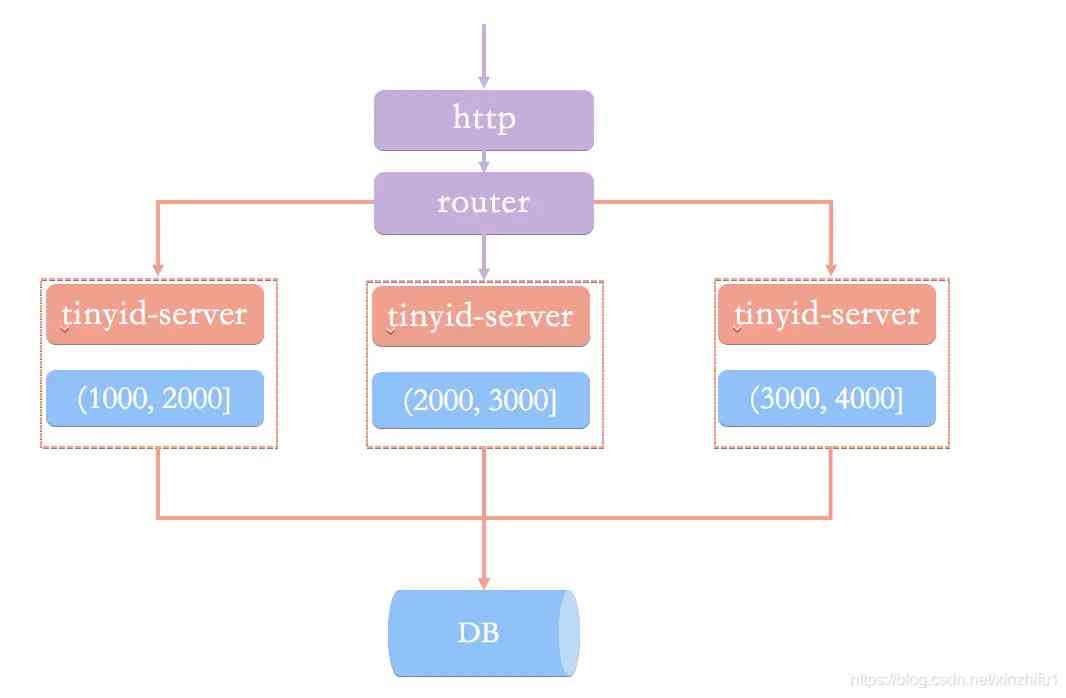当前位置:网站首页>滴滴的分布式ID生成器(Tinyid),好用的一批
滴滴的分布式ID生成器(Tinyid),好用的一批
2020-11-07 16:59:00 【osc_kl6fknqf】
不了解分布式ID生成器的同学,先复习一下之前的 《9种分布式ID生成方式》
Tinyid是滴滴开发的一款分布式ID系统,Tinyid是在美团(Leaf)的leaf-segment算法基础上升级而来,不仅支持了数据库多主节点模式,还提供了tinyid-client客户端的接入方式,使用起来更加方便。但和美团(Leaf)不同的是,Tinyid只支持号段一种模式不支持雪花模式。
Tinyid的特性
- 全局唯一的long型ID
- 趋势递增的id
- 提供 http 和 java-client 方式接入
- 支持批量获取ID
- 支持生成1,3,5,7,9...序列的ID
- 支持多个db的配置
适用场景:只关心ID是数字,趋势递增的系统,可以容忍ID不连续,可以容忍ID的浪费
不适用场景:像类似于订单ID的业务,因生成的ID大部分是连续的,容易被扫库、或者推算出订单量等信息
Tinyid原理
Tinyid是基于号段模式实现,再简单啰嗦一下号段模式的原理:就是从数据库批量的获取自增ID,每次从数据库取出一个号段范围,例如 (1,1000] 代表1000个ID,业务服务将号段在本地生成1~1000的自增ID并加载到内存.。
Tinyid会将可用号段加载到内存中,并在内存中生成ID,可用号段在首次获取ID时加载,如当前号段使用达到一定比例时,系统会异步的去加载下一个可用号段,以此保证内存中始终有可用号段,以便在发号服务宕机后一段时间内还有可用ID。
原理图大致如下图:
 Tinyid原理图
Tinyid原理图
Tinyid实现
Tinyid的GitHub地址 : https://github.com/didi/tinyid.git
Tinyid提供了两种调用方式,一种基于Tinyid-server提供的http方式,另一种Tinyid-client客户端方式。 不管使用哪种方式调用,搭建Tinyid都必须提前建表tiny_id_info、tiny_id_token。
CREATE TABLE `tiny_id_info` (
`id` bigint(20) unsigned NOT NULL AUTO_INCREMENT COMMENT '自增主键',
`biz_type` varchar(63) NOT NULL DEFAULT '' COMMENT '业务类型,唯一',
`begin_id` bigint(20) NOT NULL DEFAULT '0' COMMENT '开始id,仅记录初始值,无其他含义。初始化时begin_id和max_id应相同',
`max_id` bigint(20) NOT NULL DEFAULT '0' COMMENT '当前最大id',
`step` int(11) DEFAULT '0' COMMENT '步长',
`delta` int(11) NOT NULL DEFAULT '1' COMMENT '每次id增量',
`remainder` int(11) NOT NULL DEFAULT '0' COMMENT '余数',
`create_time` timestamp NOT NULL DEFAULT '2010-01-01 00:00:00' COMMENT '创建时间',
`update_time` timestamp NOT NULL DEFAULT '2010-01-01 00:00:00' COMMENT '更新时间',
`version` bigint(20) NOT NULL DEFAULT '0' COMMENT '版本号',
PRIMARY KEY (`id`),
UNIQUE KEY `uniq_biz_type` (`biz_type`)
) ENGINE=InnoDB AUTO_INCREMENT=1 DEFAULT CHARSET=utf8 COMMENT 'id信息表';
CREATE TABLE `tiny_id_token` (
`id` int(11) unsigned NOT NULL AUTO_INCREMENT COMMENT '自增id',
`token` varchar(255) NOT NULL DEFAULT '' COMMENT 'token',
`biz_type` varchar(63) NOT NULL DEFAULT '' COMMENT '此token可访问的业务类型标识',
`remark` varchar(255) NOT NULL DEFAULT '' COMMENT '备注',
`create_time` timestamp NOT NULL DEFAULT '2010-01-01 00:00:00' COMMENT '创建时间',
`update_time` timestamp NOT NULL DEFAULT '2010-01-01 00:00:00' COMMENT '更新时间',
PRIMARY KEY (`id`)
) ENGINE=InnoDB AUTO_INCREMENT=1 DEFAULT CHARSET=utf8 COMMENT 'token信息表';
INSERT INTO `tiny_id_info` (`id`, `biz_type`, `begin_id`, `max_id`, `step`, `delta`, `remainder`, `create_time`, `update_time`, `version`)
VALUES
(1, 'test', 1, 1, 100000, 1, 0, '2018-07-21 23:52:58', '2018-07-22 23:19:27', 1);
INSERT INTO `tiny_id_info` (`id`, `biz_type`, `begin_id`, `max_id`, `step`, `delta`, `remainder`, `create_time`, `update_time`, `version`)
VALUES
(2, 'test_odd', 1, 1, 100000, 2, 1, '2018-07-21 23:52:58', '2018-07-23 00:39:24', 3);
INSERT INTO `tiny_id_token` (`id`, `token`, `biz_type`, `remark`, `create_time`, `update_time`)
VALUES
(1, '0f673adf80504e2eaa552f5d791b644c', 'test', '1', '2017-12-14 16:36:46', '2017-12-14 16:36:48');
INSERT INTO `tiny_id_token` (`id`, `token`, `biz_type`, `remark`, `create_time`, `update_time`)
VALUES
(2, '0f673adf80504e2eaa552f5d791b644c', 'test_odd', '1', '2017-12-14 16:36:46', '2017-12-14 16:36:48');
tiny_id_info表是具体业务方号段信息数据表
max_id :号段的最大值
step:步长,即为号段的长度
biz_type:业务类型
号段获取对max_id字段做一次update操作,update max_id= max_id + step,更新成功则说明新号段获取成功,新的号段范围是(max_id ,max_id +step]。
tiny_id_token是一个权限表,表示当前token可以操作哪些业务的号段信息。
修改tinyid-server中 \offline\application.properties 文件配置数据库,由于tinyid支持数据库多master模式,可以配置多个数据库信息。启动 TinyIdServerApplication 测试一下。
datasource.tinyid.primary.driver-class-name=com.mysql.jdbc.Driver
datasource.tinyid.primary.url=jdbc:mysql://127.0.0.1:3306/xin-master?autoReconnect=true&useUnicode=true&characterEncoding=UTF-8
datasource.tinyid.primary.username=junkang
datasource.tinyid.primary.password=junkang
datasource.tinyid.primary.testOnBorrow=false
datasource.tinyid.primary.maxActive=10
datasource.tinyid.secondary.driver-class-name=com.mysql.jdbc.Driver
datasource.tinyid.secondary.url=jdbc:mysql://localhost:3306/db2?autoReconnect=true&useUnicode=true&characterEncoding=UTF-8
datasource.tinyid.secondary.username=root
datasource.tinyid.secondary.password=123456
datasource.tinyid.secondary.testOnBorrow=false
datasource.tinyid.secondary.maxActive=10
1、Http方式
tinyid内部一共提供了四个http接口来获取ID和号段。
package com.xiaoju.uemc.tinyid.server.controller;
/**
* @author du_imba
*/
@RestController
@RequestMapping("/id/")
public class IdContronller {
private static final Logger logger = LoggerFactory.getLogger(IdContronller.class);
@Autowired
private IdGeneratorFactoryServer idGeneratorFactoryServer;
@Autowired
private SegmentIdService segmentIdService;
@Autowired
private TinyIdTokenService tinyIdTokenService;
@Value("${batch.size.max}")
private Integer batchSizeMax;
@RequestMapping("nextId")
public Response<List<Long>> nextId(String bizType, Integer batchSize, String token) {
Response<List<Long>> response = new Response<>();
try {
IdGenerator idGenerator = idGeneratorFactoryServer.getIdGenerator(bizType);
List<Long> ids = idGenerator.nextId(newBatchSize);
response.setData(ids);
} catch (Exception e) {
response.setCode(ErrorCode.SYS_ERR.getCode());
response.setMessage(e.getMessage());
logger.error("nextId error", e);
}
return response;
}
@RequestMapping("nextIdSimple")
public String nextIdSimple(String bizType, Integer batchSize, String token) {
String response = "";
try {
IdGenerator idGenerator = idGeneratorFactoryServer.getIdGenerator(bizType);
if (newBatchSize == 1) {
Long id = idGenerator.nextId();
response = id + "";
} else {
List<Long> idList = idGenerator.nextId(newBatchSize);
StringBuilder sb = new StringBuilder();
for (Long id : idList) {
sb.append(id).append(",");
}
response = sb.deleteCharAt(sb.length() - 1).toString();
}
} catch (Exception e) {
logger.error("nextIdSimple error", e);
}
return response;
}
@RequestMapping("nextSegmentId")
public Response<SegmentId> nextSegmentId(String bizType, String token) {
try {
SegmentId segmentId = segmentIdService.getNextSegmentId(bizType);
response.setData(segmentId);
} catch (Exception e) {
response.setCode(ErrorCode.SYS_ERR.getCode());
response.setMessage(e.getMessage());
logger.error("nextSegmentId error", e);
}
return response;
}
@RequestMapping("nextSegmentIdSimple")
public String nextSegmentIdSimple(String bizType, String token) {
String response = "";
try {
SegmentId segmentId = segmentIdService.getNextSegmentId(bizType);
response = segmentId.getCurrentId() + "," + segmentId.getLoadingId() + "," + segmentId.getMaxId()
+ "," + segmentId.getDelta() + "," + segmentId.getRemainder();
} catch (Exception e) {
logger.error("nextSegmentIdSimple error", e);
}
return response;
}
}
nextId、nextIdSimple都是获取下一个ID,nextSegmentIdSimple、getNextSegmentId是获取下一个可用号段。区别在于接口是否有返回状态。
nextId:
'http://localhost:9999/tinyid/id/nextId?bizType=test&token=0f673adf80504e2eaa552f5d791b644c'
response :
{
"data": [2],
"code": 200,
"message": ""
}
nextId Simple:
'http://localhost:9999/tinyid/id/nextIdSimple?bizType=test&token=0f673adf80504e2eaa552f5d791b644c'
response: 3


2、Tinyid-client客户端
如果不想通过http方式,Tinyid-client客户端也是一种不错的选择。
引用 tinyid-server包
<dependency>
<groupId>com.xiaoju.uemc.tinyid</groupId>
<artifactId>tinyid-client</artifactId>
<version>${tinyid.version}</version>
</dependency>
启动 tinyid-server项目打包后得到 tinyid-server-0.1.0-SNAPSHOT.jar ,设置版本${tinyid.version}为0.1.0-SNAPSHOT。
在我们的项目 application.properties 中配置 tinyid-server服务的请求地址 和 用户身份token
tinyid.server=127.0.0.1:9999
tinyid.token=0f673adf80504e2eaa552f5d791b644c```
在Java代码调用TinyId也很简单,只需要一行代码。
// 根据业务类型 获取单个ID
Long id = TinyId.nextId("test");
// 根据业务类型 批量获取10个ID
List<Long> ids = TinyId.nextId("test", 10);
Tinyid整个项目的源码实现也是比较简单,像与数据库交互更直接用jdbcTemplate实现
@Override
public TinyIdInfo queryByBizType(String bizType) {
String sql = "select id, biz_type, begin_id, max_id," +
" step, delta, remainder, create_time, update_time, version" +
" from tiny_id_info where biz_type = ?";
List<TinyIdInfo> list = jdbcTemplate.query(sql, new Object[]{bizType}, new TinyIdInfoRowMapper());
if(list == null || list.isEmpty()) {
return null;
}
return list.get(0);
}
总结
两种方式推荐使用Tinyid-client,这种方式ID为本地生成,号段长度(step)越长,支持的qps就越大,如果将号段设置足够大,则qps可达1000w+。而且tinyid-client 对tinyid-server 访问变的低频,减轻了server端的压力。
版权声明
本文为[osc_kl6fknqf]所创,转载请带上原文链接,感谢
https://my.oschina.net/u/4399347/blog/4707582
边栏推荐
- Stm32f030c6t6 compatible to replace mm32spin05pf
- RFID fixed assets management system for fire equipment
- Gantt chart grouping activities tutorial
- JVM class loading mechanism
- 一种超参数优化技术-Hyperopt
- 抽絲剝繭——門面和調停者設計模式
- Using JSON webtoken (JWT) to generate token in nodejs
- JS string - string string object method
- How to solve the problem of blank page in Google Chrome browser
- Insomnia all night
猜你喜欢

Insomnia all night

Benefits and functions of auto maintenance app development

jenkins pipline stage 设置超时

WebAPI接口设计:SwaggerUI文档 / 统一响应格式 / 统一异常处理 / 统一权限验证

Windows 10 Bluetooth management page 'add Bluetooth or other devices' option click no response solution

大佬们如何在nginx镜像里面增加模块?

Characteristics of magnetic memory chip STT-MRAM

Developing STM32 USB with cubemx

Google browser realizes video playback acceleration function

Win7 AppCrash (solution)
随机推荐
[note] error while loading pyv8 binary: exit code 1 solution
How to solve the problem of blank page in Google Chrome browser
Gantt chart grouping activities tutorial
Developing STM32 USB with cubemx
条形码识别性能低,如何优化Dynamsoft Barcode Reader解码性能
git 提交规范
Chinese sub forum of | 2020 PostgreSQL Asia Conference: Pan Juan
How does varhart xgantt represent working days on a calendar
2020-08-15: under what circumstances should data tasks be optimized?
Nonvolatile MRAM memory used in all levels of cache
汽车维修app开发的好处与功能
In 2020, how can wechat seal numbers be quickly lifted?
Talk about sharing before paying
Implementation of nginx version of microservice architecture
How does LeadTools detect, read and write barcodes
如何利用PopupWindow实现弹出菜单并解决焦点获取以及与软键盘冲突问题
The first choice for lightweight GPU applications is the NVIDIA vgpu instance launched by Jingdong Zhilian cloud
Jenkins入门(二)声明式流水线Jenkins Pipeline
How to create an interactive kernel density chart
Come on in! Take a few minutes to see how reentrantreadwritelock works!